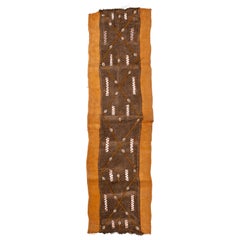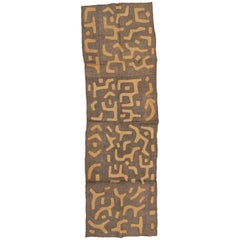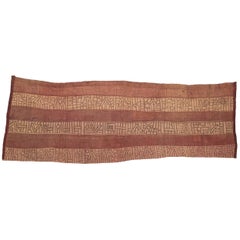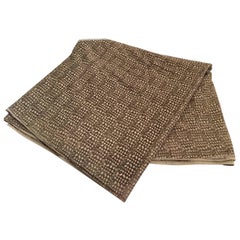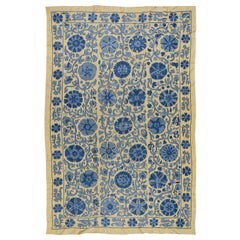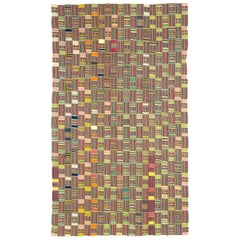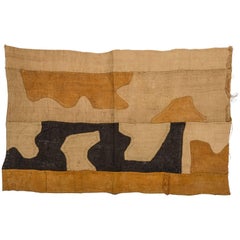Sub-Saharan African Textiles
6
to
4
4
2
6
6
6
4
1
6
5
1
4
4
4
4
4,617
1,419
598
578
564
1
Place of Origin: Sub-Saharan African
African Batik Cloth Natural Hand-woven Hand-Printed Cotton Fabric Ghana 10 Yards
Located in North Hollywood, CA
African Batik Cloth Natural Hand-woven Hand-Printed Cotton Fabric Ghana 10 yards.
Colors are organic earth tone beige and light brown in geometric design.
Non waxed fabric circa 1950s.
Hand made in Ghana Africa.
Museum Quality Original Long Piece.
380 inches, (30 ft 10 yards Long) x 46 inches Inches Wide( 4ft).
Could be use to make pillows or upholstery.
History of Batik in Africa:
Batik, a traditional fabric art technique, has a rich history in Ghana, West Africa. The practice of batik involves using wax to create intricate patterns on fabric, which is then dyed to achieve the desired design. While batik has its origins in Asia, particularly in Indonesia, it has been embraced and adapted by various African countries, including Ghana.
In Ghana, batik-making can be traced back to the mid-20th century when it gained popularity as a form of traditional textile art. The craft was introduced by artists and artisans who were inspired by the vibrant and expressive nature of batik. These early practitioners experimented with different designs, colors, and patterns, infusing local themes and motifs into their creations.
Over time, batik became an important part of Ghanaian culture and identity. It is not only used for clothing but also for various decorative and functional items such as wall hangings, tablecloths, and accessories. The art form often reflects the rich cultural heritage of Ghana, incorporating symbols, proverbs, and traditional stories into the designs.
Ghanaian batik artists often employ a combination of traditional and contemporary elements, creating a unique fusion of styles. The process of making batik involves applying hot wax to the fabric using various tools to create the desired patterns. The wax acts as a resist, preventing dye from penetrating the waxed areas. After dyeing, the wax is removed, revealing the intricate designs on the fabric.
Today, batik-making in Ghana continues to thrive as both a traditional craft and a form of artistic expression. Many artisans and designers draw inspiration from Ghana's diverse cultural landscape, incorporating elements from different regions and ethnic groups into their batik creations. The art form has also gained international recognition, with Ghanaian batik products being sought after both locally and abroad.
In summary, the history of batik in Ghana is a testament to the creativity and adaptability of artists who have embraced and transformed this traditional technique into a vibrant and culturally significant art form within the country.
HISTORY OF BATIK
In the mid-nineteenth century, the Belanda Hitam, or "Black Dutchmen," are said to have introduced batik to West Africa after serving as indentured soldiers for the Dutch in Indonesia. Returning from their conscriptions with trunks of fine Javanese batik, the opulent patterns captured the imagination of their friends and relatives. However, textile history is complex, and only a handful of recruits returned to West Africa with batik due to delayed payments.
Batik, with roots traced to Egyptian mummies, is a tradition found globally, from Southeast Asia to Japan and India. Europeans, particularly the Dutch, played a significant role in industrializing batik from the seventeenth century onward.
In West Africa, Dutch Scholar Ineke van Kessel suggests that batik arrived from India over trans-Saharan routes. Local populations, like the Yoruba in Nigeria, incorporated wax printing into their textiles. European traders brought wax and non-wax fabrics to West Africa in the seventeenth century, targeting a population ready for their consumption. European designers adapted prints for the African market...
Category
Mid-20th Century Folk Art Sub-Saharan African Textiles
Materials
Cotton
African Textile Kuba, suitable for table or Wall Hanging or Backrest Covering
By Kuba
Located in Alessandria, Piemonte
B/1676. Old African textile from Kuba, Zaire: with small shells as ornament.
An IDEA: use this item as backrest covering of a sofa !
Category
Mid-20th Century Folk Art Sub-Saharan African Textiles
Materials
Raffia, Cotton
African Textile Panel with Shells
Located in Alessandria, Piemonte
Old African textile panel with shells,: You can mount on a panel for wall, or place on table, or mount as lampshade. Its colors are sunny. It's wonderful for a sea-house !
B/1677-1
Category
Mid-20th Century Modern Sub-Saharan African Textiles
Materials
Raffia
African Kuba Textile Panel for Wall or Table or Backrest Covering
Located in Alessandria, Piemonte
Vintage Handwoven and hand died raffia panel - Suitable for wall decoration, a long table or to make cushions -
An IDEA: use this item as backrest covering...
Category
1930s Tribal Vintage Sub-Saharan African Textiles
Materials
Raffia
African Textile by Kuba, Zaire - for Backrest Cover
Located in Alessandria, Piemonte
B/874/1 - Vintage African Kuba textile, suitable for Wall hanging or table -
An IDEA: use this item as backrest covering of a sofa !
Category
Mid-20th Century Folk Art Sub-Saharan African Textiles
Materials
Raffia, Cotton
Woven African Tribal Bogalan Mud Cloth Textile
Located in North Hollywood, CA
Handwoven Bogolan mud cloth textile from Mali, Africa, Bambara.
It is a handwoven tribal cotton fabric traditionally dyed with fermented mud.
Woven Afr...
Category
20th Century Folk Art Sub-Saharan African Textiles
Materials
Cotton
Related Items
Decorative Uzbek Suzani Textile, Embroidered Cotton & Silk Wall Hanging
Located in Philadelphia, PA
In the most technical sense of the word, "Suzani," in Central Asia and Iran, means needle and is used to describe this type of needlework, but to most people, such as decorators or c...
Category
21st Century and Contemporary Suzani Sub-Saharan African Textiles
Materials
Cotton, Silk
Free Shipping
H 82.68 in W 56.3 in D 0.04 in
African Ewe Kente Cloth Textile/Wall Hanging
Located in New York, NY
This prestigious Kente cloth was handwoven on small hand held looms. The fabric has all been hand sewn to form a marvelous textile. These were originally m...
Category
Mid-20th Century Tribal Sub-Saharan African Textiles
Materials
Cotton
Uzbek Suzani Fabric Throw Pillow, Embroidered Cotton & Silk Cushion Cover
Located in Philadelphia, PA
In the most technical sense of the word, "Suzani," in Central Asia and Iran, means needle and is used to describe this type of needlework, but to most people, such as decorators or c...
Category
21st Century and Contemporary Suzani Sub-Saharan African Textiles
Materials
Cotton, Silk
Free Shipping
H 18.12 in W 17.72 in D 0.04 in
Hand-woven mid-century "orange sun" wall carpet
Located in Budapest, HU
Handmade, hand-waved mid-century style wall carpet in orange-red-black color combination. We've forgotten about these wonderful pieces for a while, but now we're bringing back the at...
Category
1970s Mid-Century Modern Vintage Sub-Saharan African Textiles
Materials
Textile, Wool
Ikat Textile from Sumba Island Tribal Motifs, Indonesia
Located in Jimbaran, Bali
This Ikat textile originates from the Island of Sumba, Indonesia. It is hand-woven using naturally dyed yarns via a method passed on through generations. It features a stunning array...
Category
1950s Other Vintage Sub-Saharan African Textiles
Materials
Yarn
Ikat Textile from Flores Island, Indonesia
Located in Jimbaran, Bali
This Ikat textile originates from the Island of Flores, Indonesia. It is hand-woven using naturally dyed yarns via a method passed on through generations. This textile is tubular for...
Category
Mid-20th Century Other Sub-Saharan African Textiles
Materials
Yarn
Modern Uzbek Suzani Textile, Embroidered Cotton & Silk Wall Hanging
Located in Philadelphia, PA
In the most technical sense of the word, "Suzani," in Central Asia and Iran, means needle and is used to describe this type of needlework, but to most people, such as decorators or c...
Category
21st Century and Contemporary Suzani Sub-Saharan African Textiles
Materials
Cotton, Silk
Free Shipping
H 82.68 in W 55.12 in D 0.04 in
Japanese Vintage Indigo Woven Ikat Kasuri Textile Panel
Located in Atlanta, GA
A Japanese hand-woven panel with indigo blue background with white ikat chevron and diamond pattern. Sewn together from four loom-woven narrower stripes, the large panel was likely a...
Category
Early 20th Century Meiji Sub-Saharan African Textiles
Materials
Cotton
"BORO" / Japanese Old Cloth / Tapestry / Wall Decoration
Located in Sammu-shi, Chiba
We have a unique Japanese sense of beauty.
We will also introduce unique items that only we can make, purchasing routes in Japan, experience gained so far, and methods that no one el...
Category
Early 20th Century Showa Sub-Saharan African Textiles
Materials
Cotton, Linen
Vintage Hand Painted Oriental Cloud Batik Indonesia Textiles Interior Design
Located in London, GB
Fine Hand painted Oriental cloud batik
A Indonesian Cirebon batik hand painted in a traditional Chinese cloud style with graduated blue and red
Per...
Category
Mid-20th Century Sub-Saharan African Textiles
Materials
Cotton
H 82.68 in W 37.8 in D 0.4 in
Framed Japanese Embroidery Textile Panel Rootsters
Located in Atlanta, GA
A matted and framed Japanese silk panel with elaborate embroidery circa late Meiji to Taisho period (1910-30s). On a bright background, two rooster...
Category
Early 20th Century Japonisme Sub-Saharan African Textiles
Materials
Silk, Wood
Very Large Ikat Textile from Sumba Island with Stunning Tribal Motifs, Indonesia
Located in Jimbaran, Bali
This Ikat textile originates from the Island of Sumba, Indonesia. It is hand-woven using naturally dyed yarns via a method passed on through generations. It features a stunning array...
Category
Late 20th Century Other Sub-Saharan African Textiles
Materials
Yarn
Free Shipping
H 114.18 in W 43.31 in D 0.02 in
Previously Available Items
Vintage African Kuba Textile Panel for Wall or Table
Located in Alessandria, Piemonte
Unusual vintage African Kuba textile, suitable for a modern wall panel, a long table or to make pillows -
B/1660.
Category
1950s Folk Art Vintage Sub-Saharan African Textiles
Materials
Raffia
African Textile Kuba Zaire, Suitable for Table, Pillow or Wall Hanging
Located in Alessandria, Piemonte
B/1702, vintage Kuba textile, from Zaire.
Ideal for pillows or wall panel.
Category
Mid-20th Century Folk Art Sub-Saharan African Textiles
Materials
Raffia
H 33.47 in W 20.87 in L 33.47 in
Recently Viewed
View AllMore Ways To Browse
Hanging Sofa
Asian Silk Embroidered Large
Asian Art Kimono
Embroidery Cloth
Bed Asian Design
Vintage Asian Embroidery
Framed Textiles Asian
Japanese Hand Woven Art
Antique Asian Embroidery
Japanese Silk Embroidered
Cloth Bed
Embroidery Screen
Embroidered Screen
Japanese Obi
Japan Obi
Vintage Embroidery Stitches
Silk Bed Cover
Asian Art And Furniture Kimono

